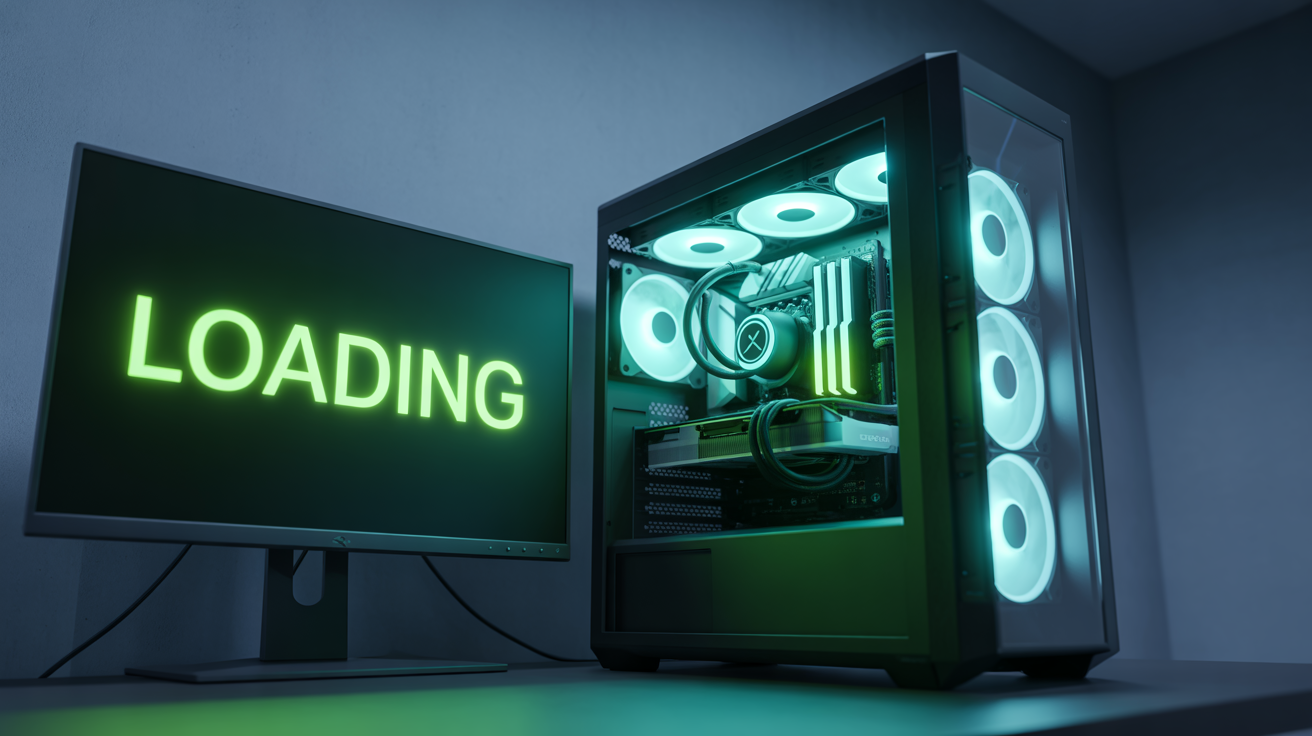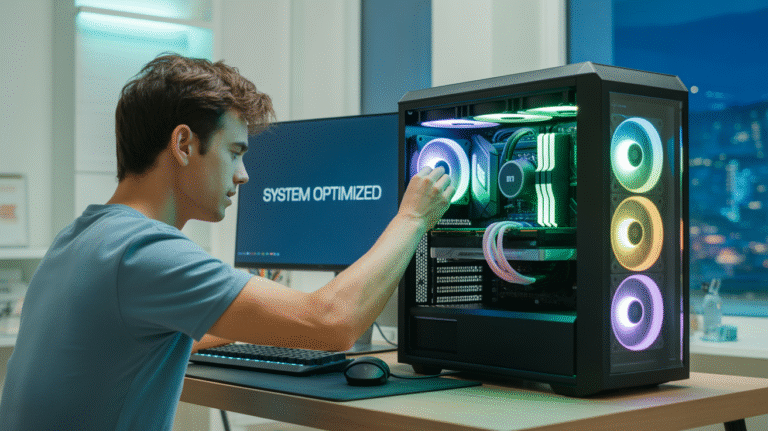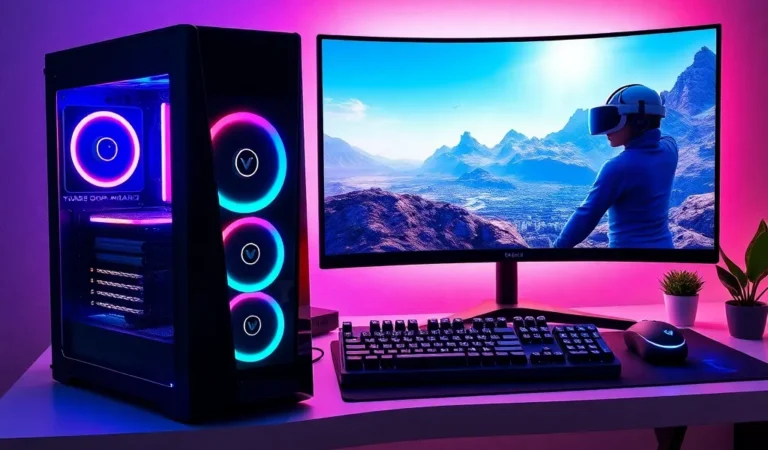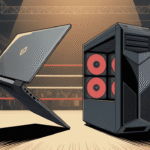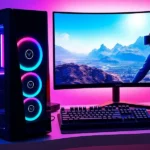Defining a “good” gaming desktop goes beyond just looking flashy. It’s fundamentally about its ability to deliver a smooth, immersive gaming experience tailored to your needs and budget. A powerful gaming rig translates directly into higher frame rates, sharper graphics, faster loading times, and the capability to run the latest titles without compromise.
Understanding the underlying component specifications is absolutely crucial. These individual parts work in concert, and the performance of one can significantly impact the overall system. Knowing what each component does and which specifications matter most will empower you to make informed decisions, whether you’re building a PC from scratch or buying a pre-built system. This guide will walk you through the key areas you need to consider to build or choose a machine that truly excels at gaming.
The Heart of Gaming: Graphics Card (GPU)

Why the GPU is Critical for Gaming
The Graphics Card (GPU) is arguably the single most important component in a gaming desktop. It’s primarily responsible for rendering everything you see on your screen, from detailed character models and complex environments to intricate visual effects like shadows, reflections, and particle systems. The GPU’s power directly dictates the graphical fidelity and, critically, the frame rate, how many individual images your display shows per second. A higher frame rate results in smoother motion and a more responsive gaming experience.
Key GPU Specifications Explained
Several specifications define a GPU’s capabilities. VRAM (Video Memory) is dedicated memory on the graphics card used to store textures, frame buffers, and other graphical data. More VRAM is essential for higher resolutions (like 1440p or 4K), using high-resolution texture packs, and enabling complex graphical settings without performance issues or stuttering.
Core Count, often referred to as CUDA Cores (NVIDIA) or Stream Processors (AMD), represents the number of processing units available on the GPU. A higher core count generally means the GPU can perform more calculations simultaneously, leading to better performance in demanding tasks. Clock Speed (often listed as a Base Clock and Boost Clock) indicates how quickly these cores operate, measured in MHz or GHz. A higher boost clock allows the GPU to perform its rendering tasks faster when under load.
Choosing the Right GPU Tier for Your Needs
GPUs are typically categorized into tiers based on their performance. An entry-level GPU is suitable for casual gaming, esports titles, or playing older games at 1080p resolution with moderate settings. They offer a solid experience for less demanding tasks without a high cost.
A mid-range GPU is often the sweet spot for many gamers, providing excellent performance for playing modern AAA titles at 1080p or 1440p resolutions with high to ultra settings. These cards offer a strong balance of performance and price. High-end or enthusiast GPUs are built for maximum performance, targeting 4K resolution gaming, ultra-high refresh rates, and demanding professional workloads. While expensive, they offer the best possible graphical experience and greater longevity for future titles.
Major GPU Manufacturers: NVIDIA GeForce vs. AMD Radeon

The two primary manufacturers of gaming GPUs are NVIDIA with their GeForce line and AMD with their Radeon line. Both companies offer a range of cards across different performance tiers. NVIDIA is often known for strong ray tracing performance and features like DLSS (Deep Learning Super Sampling), which uses AI to boost frame rates.
AMD typically competes strongly in raw rasterization performance (standard 3D rendering) and offers features like FidelityFX Super Resolution (FSR), an open-source upscaling technology. The choice between the two often comes down to specific models at your target performance tier, desired features, and current pricing.
The Engine: Central Processing Unit (CPU)

How the CPU Impacts Gaming Performance
While the GPU handles graphics, the Central Processing Unit (CPU), often called the “brain” of the computer, is responsible for managing all the non-graphical aspects of a game. This includes complex tasks like processing game logic, controlling Artificial Intelligence (AI) behaviors, calculating physics interactions, managing game state, and organizing data to be sent to the GPU. A powerful CPU ensures that the GPU is constantly fed instructions and data without delays, preventing a performance bottleneck.
Key CPU Specifications Explained
Cores are the individual processing units within a CPU, and Threads are virtual cores that allow a single physical core to handle multiple tasks concurrently. More cores and threads enable the CPU to manage complex game environments, background applications, and operating system tasks more efficiently. This is particularly important in open-world games or those with extensive AI.
Clock Speed (Base and Boost) indicates how many instruction cycles the CPU can perform per second. A higher clock speed generally means the CPU can complete tasks faster, improving responsiveness. Cache Size is a small amount of very fast memory on the CPU that stores frequently accessed data. A larger cache can speed up data retrieval, reducing the time the CPU spends waiting.
Major CPU Manufacturers: Intel Core vs. AMD Ryzen
The main competitors in the CPU market for gaming are Intel with their Core series and AMD with their Ryzen series. Both companies offer CPUs with varying core counts, clock speeds, and architectures across different price points. Intel has historically been strong in per-core performance, which is crucial for gaming, while AMD has focused on providing higher core counts at competitive prices, excelling in multitasking and productivity alongside gaming.
Modern CPUs from both manufacturers offer excellent gaming performance, and the best choice often depends on your budget, desired core count for other tasks (like streaming or video editing), and platform features.
Balancing CPU and GPU for Optimal Performance
Achieving optimal gaming performance requires a balance between the CPU and GPU. A powerful GPU paired with a weak CPU can result in a CPU bottleneck, where the CPU cannot process game logic and feed data to the GPU fast enough, causing the GPU to sit idle part of the time. Conversely, a powerful CPU with a weak GPU will lead to a GPU bottleneck, where the GPU is the limiting factor in frame rate, regardless of how fast the CPU is. Aim to pair components from similar performance tiers to ensure they work together effectively and avoid significant bottlenecks.
Speed and Multitasking: Random Access Memory (RAM)

How RAM Affects Gaming
Random Access Memory (RAM) is a type of volatile memory used to store temporary data that the CPU needs to access quickly. In gaming, RAM holds essential information such as game textures, level data, running processes, and operating system files. When the CPU needs data, it retrieves it from RAM far faster than from storage drives (SSDs or HDDs). Insufficient or slow RAM can lead to stuttering, longer loading times, and reduced performance, especially in games with large open worlds or complex scenes.
Key RAM Specifications Explained
The primary specification is Capacity, measured in gigabytes (GB). This determines how much data the RAM can hold. Speed, measured in megahertz (MHz), indicates how quickly the RAM can transfer data. Higher speeds mean faster data access for the CPU. Latency, often denoted by CAS Latency (CL), measures the delay between the CPU requesting data from the RAM and it being available. Lower latency is better.
Modern gaming PCs typically use DDR4 or the newer, faster DDR5 technology. RAM is usually installed in pairs of sticks (e.g., 2x 8GB or 2x 16GB) to enable dual-channel mode, which significantly increases the bandwidth and improves performance compared to a single stick.
Recommended RAM Capacities and Speeds for Modern Gaming
For casual gaming and most esports titles, 8GB of RAM is often the minimum required, but it can be limiting. 16GB of RAM is widely considered the standard for modern AAA gaming, providing ample capacity for most titles and background applications. For heavy multitaskers, future-proofing, or specific demanding simulations, 32GB of RAM might be beneficial.
Regarding speed, aiming for 3200MHz to 3600MHz for DDR4 is a good balance of performance and cost. For DDR5, speeds of 4800MHz and above are common, offering significantly higher bandwidth. Always check your motherboard and CPU specifications to ensure compatibility with your chosen RAM speed and type.
Loading Times and Storage: Storage Solutions

The Importance of Fast Storage for Gaming
Your storage solution significantly impacts the speed at which games load, levels transition, and in-game assets stream. Slow storage can result in long loading screens and even texture pop-in or stuttering as the game struggles to load data quickly enough. Fast storage is essential for a smooth and responsive gaming experience, especially in modern games with large file sizes and detailed environments.
Solid State Drives (SSDs)

Solid State Drives (SSDs) use flash memory instead of spinning platters, offering dramatically faster read and write speeds compared to traditional hard drives. They are the minimum recommended storage for your operating system and frequently played games in a gaming PC.
There are two main types of SSDs relevant to gaming:
- NVMe SSDs: These connect via the M.2 slot on your motherboard and utilize the PCIe interface, offering the fastest speeds available (often several times faster than SATA SSDs). They are ideal for your operating system, frequently played games with large worlds, and applications where load times are critical.
- SATA SSDs: These connect via a SATA cable and are limited by the SATA interface speed, which is slower than PCIe. While not as fast as NVMe, they are still significantly faster than HDDs and are a good choice for storing more games or as a general-purpose fast drive if M.2 slots are limited or budgets are tighter.
Hard Disk Drives (HDDs)

Hard Disk Drives (HDDs) use spinning magnetic platters to store data. They offer significantly lower speeds than SSDs but provide a much lower cost per gigabyte. HDDs are suitable for mass storage of large game libraries that don’t require lightning-fast loading (like older or less demanding titles), media files, or backups. They are not recommended for installing your operating system or primary gaming library if you want quick load times.
Recommended Storage Configurations
A common and highly effective configuration for a gaming desktop is a combination of an SSD and an HDD. Install your operating system, essential applications, and your most played, demanding games on a fast NVMe SSD for rapid boot and load times. Use a larger capacity HDD (e.g., 1TB, 2TB, or more) for storing the rest of your game library, media, and less frequently accessed files. Alternatively, if budget allows, using a larger SATA SSD or even multiple NVMe SSDs offers a fully flash-based storage solution with excellent speeds across the board.
The Foundation: Motherboard

What the Motherboard Does in a Gaming PC
The Motherboard is the central printed circuit board that connects and allows communication between all the other components in your PC. It’s the foundation upon which you build your system. The motherboard houses the CPU socket, RAM slots, expansion slots for GPUs and other cards, M.2 slots for SSDs, SATA ports, and various connectors for peripherals.
Key Motherboard Features to Consider
Several features on a motherboard impact your system’s capabilities and future upgradability. The Chipset is a set of integrated circuits that manage data flow between the CPU and other components. It determines CPU compatibility, the number and type of expansion slots, USB ports, SATA ports, and often, overclocking support. Ensure the chipset is compatible with your chosen CPU generation.
PCIe Slots are crucial for installing the graphics card (usually the top, reinforced slot operating at full x16 speed) and potentially other expansion cards like capture cards or sound cards. Pay attention to the PCIe generation supported (PCIe 4.0 or the newer PCIe 5.0) as it affects bandwidth, especially for modern GPUs and NVMe SSDs. M.2 Slots are specifically for compact NVMe or SATA SSDs. Check the number of slots and the types of SSDs they support (NVMe/SATA).
The number of RAM Slots (typically 2 or 4 on mainstream boards) determines how many RAM sticks you can install. Also, verify the maximum RAM Speed and Capacity the motherboard supports. Finally, consider Connectivity, including the number and type of USB ports (USB 3.2 Gen 1, Gen 2, etc.), display outputs (though usually from the GPU), Ethernet ports for wired internet, and potentially integrated Wi-Fi and Bluetooth.
Ensuring Motherboard Compatibility with CPU
One of the most critical compatibility checks is ensuring the motherboard’s CPU Socket type matches that of your chosen CPU (e.g., Intel’s LGA 1700 or AMD’s AM5). Additionally, the motherboard’s chipset must support the specific generation of your CPU. While some motherboards support multiple CPU generations with a BIOS update, it’s essential to verify this compatibility before purchasing.
Powering the System: Power Supply Unit (PSU)

Why PSU Quality and Wattage Matter
The Power Supply Unit (PSU) provides electrical power to all the components in your computer. It’s vital to choose a PSU that can reliably deliver enough power for your system’s needs. An undersized or low-quality PSU can lead to system instability, crashes, or even prevent components from working correctly under load. A good quality PSU ensures stable voltage delivery, crucial for component health and performance.
Calculating Required PSU Wattage
The total power consumption of your system is the sum of the power drawn by each component, with the GPU and CPU typically being the most power-hungry. Manufacturers often provide recommended PSU wattage for specific GPUs. It’s best practice to estimate the total power draw of your components and then choose a PSU with a wattage significantly higher than that estimate (adding a safety margin, typically 15-30%). Online PSU calculators can help estimate your system’s power needs based on your chosen components.
PSU Efficiency Ratings (80 Plus Bronze, Gold, Platinum)
PSUs have efficiency ratings certified by the 80 Plus program (e.g., 80 Plus Bronze, Gold, Platinum, Titanium). This rating indicates how efficiently the PSU converts AC wall power into usable DC power for your components. A higher efficiency rating means less power is wasted as heat, resulting in lower electricity bills and less heat output from the PSU itself. While a Bronze rating is acceptable, Gold or higher ratings are often recommended for gaming PCs for better efficiency and often higher build quality.
Keeping it Cool: Cooling Solutions

The Need for Effective Cooling in Gaming Desktops
High-performance components like powerful CPUs and GPUs generate a significant amount of heat, especially when under heavy load during gaming. Effective cooling is essential to dissipate this heat. Without proper cooling, components can reach high temperatures, leading to thermal throttling where performance is automatically reduced to prevent damage. Good cooling ensures components can operate at their peak performance levels consistently and contributes to their longevity.
Types of Cooling: Air Cooling vs. Liquid Cooling
The two primary types of cooling for CPUs are air cooling and liquid cooling. Air coolers use a heatsink with fins and heat pipes to draw heat away from the CPU and dissipate it using fans. They are generally simpler, more affordable, and reliable.
Liquid coolers, or All-in-One (AIO) liquid coolers, use a pump to circulate a liquid coolant through a water block on the CPU, which absorbs heat. The heated liquid then travels to a radiator with fans that dissipate the heat. Liquid coolers can offer potentially better cooling performance and a cleaner look, but they are typically more expensive and have more potential points of failure (pump, leaks). For GPUs, cooling solutions are integrated onto the card itself, using fans and heatsinks or sometimes built-in liquid cooling loops on high-end models.
Optimizing Case Fan Configuration and Airflow
Beyond CPU and GPU coolers, proper case airflow is crucial for keeping all components cool. This involves using case fans to draw cool air into the case (intake fans) and expel hot air (exhaust fans). A good airflow configuration typically involves intake fans at the front or bottom and exhaust fans at the rear or top. The PC case’s design, including mesh panels and fan mounting options, significantly impacts how effectively air can flow through the system. Optimizing fan placement and speed profiles helps maintain lower overall system temperatures.
Housing the Components: The PC Case

A. Functionality and Form Factor (ATX, Micro-ATX, Mini-ITX)
The PC Case serves as the enclosure for all your computer’s components. Its primary function is to protect the internal hardware, provide mounting points for components, and facilitate airflow for cooling. Cases come in various form factors, primarily based on the size of the motherboard they support:
- ATX: The standard size, offering ample space for components, expansion slots, and cooling solutions.
- Micro-ATX: A smaller size, supporting Micro-ATX motherboards and fewer expansion slots, suitable for more compact builds.
- Mini-ITX: The smallest standard size, supporting Mini-ITX motherboards, ideal for highly compact or small form factor PCs, but often with limited expansion and cooling options.
Case Features Affecting Airflow and Cooling Support
A good gaming case prioritizes airflow. Look for cases with mesh front panels or large ventilation areas to allow for unobstructed air intake. The number and size of fan mounts dictate how many case fans you can install and what size radiators (for liquid cooling) the case can accommodate. Sufficient space behind the motherboard tray for cable management is also important for improving airflow and aesthetics.
Front Panel Connectivity and Convenience
Consider the front panel or top panel connectivity options. Easy access to USB ports (especially high-speed USB 3.0 or 3.2) and audio jacks for headphones and microphones is a significant convenience. Some cases also include USB-C ports, fan speed controllers, or RGB lighting controls on the front panel.
X. The Operating System (OS)

Why the OS Matters for Gaming
The Operating System (OS) is the software that manages all the hardware and software resources on your computer. For gaming, the OS is crucial because it provides the platform for games to run, manages drivers for your hardware, and offers support for graphics APIs (Application Programming Interfaces) like DirectX (Windows) and Vulkan (cross-platform). The OS also handles background processes that can impact gaming performance.
Windows as the Primary Gaming Platform
Microsoft Windows is the dominant operating system for PC gaming. Its widespread adoption means the vast majority of games are developed and optimized primarily for Windows. The latest versions of Windows (currently Windows 10 and Windows 11) offer features like Game Mode, optimizations for modern hardware, and robust driver support from component manufacturers. While Linux and macOS can run some games (often via compatibility layers or specific ports), Windows remains the go-to OS for the broadest compatibility and best performance in most titles.
XI. Putting It All Together: System Synergy and Bottlenecking

Understanding How Components Work Together
A gaming desktop is more than just a collection of powerful parts; it’s a system where components must work together harmoniously. The CPU processes game logic and sends drawing instructions to the GPU. The GPU renders the graphics and sends them to the display. RAM stores the data needed by both the CPU and GPU. Fast storage ensures this data is loaded quickly. The motherboard facilitates communication, the PSU provides power, and cooling keeps everything running smoothly. System synergy means ensuring these parts are well-matched in terms of performance and capability.
Identifying and Avoiding Common Bottlenecks
A bottleneck occurs when one component is significantly less powerful than others, limiting the overall system performance. As discussed, the most common bottlenecks in gaming are between the CPU and GPU. A CPU bottleneck means the CPU can’t keep up with the GPU, while a GPU bottleneck means the GPU is the limiting factor. To avoid bottlenecks, choose components from similar performance tiers. For example, pair a high-end GPU with a high-end CPU, a mid-range GPU with a mid-range CPU, and so on. Researching benchmarks for your desired CPU and GPU combination for the games you want to play can help predict potential bottlenecks.
Budget Considerations

Allocating Budget Among Key Components
Building or buying a gaming PC involves managing a budget effectively. Generally, for gaming performance, the GPU and CPU should receive the largest portion of your budget. These two components have the most significant impact on frame rates and graphical settings.
Where to Potentially Save vs. Where to Invest More
You can potentially save money on components that have less direct impact on gaming performance but still need to meet minimum requirements. This might include choosing a slightly less expensive motherboard (as long as it has the necessary features and compatibility), a more budget-friendly case with good airflow, or a standard SATA SSD instead of a top-tier NVMe for your secondary storage. However, do not compromise significantly on the PSU (for stability and safety) or cooling (to prevent thermal throttling). Investing in a good quality PSU and sufficient cooling pays off in system stability and longevity.
Future-Proofing and Upgradability

Planning for Future Component Upgrades
While no PC is truly “future-proof” indefinitely, you can make choices that allow for easier upgrades down the line. Selecting a motherboard with a recent chipset and CPU socket that is likely to support future CPU generations can extend the platform’s lifespan. Choosing a PSU with adequate wattage headroom allows you to upgrade to a more powerful GPU or CPU later without needing a new power supply.
Considering Platform Longevity
The CPU socket and the supported RAM technology (DDR4 vs. DDR5) are key factors in platform longevity. Motherboards supporting newer technologies and sockets typically have a longer upgrade path as new compatible CPUs and faster RAM modules are released. Investing in a motherboard and CPU platform that is relatively current provides more options for future upgrades compared to a platform nearing the end of its support cycle.
Connectivity and Peripherals

Essential Ports for Gaming and Connectivity
A good gaming desktop needs robust connectivity for peripherals and networking. Ensure the motherboard and GPU offer sufficient Display Outputs (DisplayPort and HDMI are standard) to connect your monitor(s). Plenty of USB ports are needed for your keyboard, mouse, headset, external drives, and other accessories. Look for a mix of USB 2.0 (for basic peripherals), USB 3.x (for faster devices), and ideally, USB-C ports. An Ethernet port is essential for a stable wired internet connection, crucial for online gaming.
Wireless Connectivity: Wi-Fi and Bluetooth
While wired Ethernet is preferred for gaming stability, integrated Wi-Fi can be convenient if your router is far from your PC. Look for motherboards or add-in cards supporting recent Wi-Fi standards (Wi-Fi 6/6E) for better speed and reliability. Bluetooth is useful for connecting wireless controllers, headsets, and other peripherals. Many motherboards with integrated Wi-Fi also include Bluetooth.
Conclusion
Building or selecting a good gaming desktop is an exciting process that involves understanding how various components contribute to the overall experience. The GPU and CPU are the primary drivers of gaming performance, dictating frame rates and graphical fidelity. Sufficient and fast RAM ensures smooth multitasking and data access. Fast storage, ideally an SSD, dramatically improves loading times.
The motherboard connects everything, the PSU provides essential power, and effective cooling prevents performance degradation. Considering the case for airflow, choosing the right OS (Windows for compatibility), ensuring system synergy to avoid bottlenecks, and planning for budget and future upgrades are all crucial steps. By focusing on these key specifications and how they interact, you can assemble or purchase a gaming desktop that provides an excellent and enjoyable gaming experience for years to come.
Frequently Asked Questions (FAQs)
Q: How much should I spend on a gaming PC?
- The ideal budget depends heavily on your target resolution, desired graphical settings, and the types of games you play. A capable 1080p gaming PC can be built for around $800-$1200, while a 1440p or 4K gaming PC typically requires a budget of $1500 or more. Consider your needs and prioritize the GPU and CPU within your budget.
Q: Is it better to build my own gaming PC or buy a pre-built one?
- Building your own PC offers greater customization, potential cost savings, and a deeper understanding of how the components work together. Pre-built PCs offer convenience, a warranty covering the entire system, and may be the only way to obtain certain high-demand components (like GPUs) during shortages. Both options have their pros and cons, so weigh your priorities.
Q: What’s more important for gaming, the CPU or the GPU?
- The GPU is generally more important for gaming as it handles the majority of the graphical rendering workload. However, the CPU is still crucial for processing game logic, AI, and physics. A balanced system with a capable CPU and GPU is essential to avoid bottlenecks.
Q: How much RAM do I need for gaming in 2024?
- 16GB of RAM is the recommended minimum for most modern games. 8GB might be sufficient for older or less demanding titles, but 16GB provides a much smoother experience and allows for background applications without impacting performance. For demanding games, heavy multitasking, or future-proofing, 32GB can be beneficial.
Q: Should I get an SSD or HDD for gaming?
- An SSD is highly recommended as the primary storage for your operating system and frequently played games. SSDs offer significantly faster loading times and improved responsiveness compared to HDDs. An HDD can be used for mass storage of less frequently played games or media files. Ideally, a combination of SSD and HDD provides the best balance of speed and capacity.
Q: What does PSU wattage mean, and how much do I need?
- PSU wattage indicates the maximum power the PSU can deliver. To determine the wattage you need, estimate the total power consumption of your components (CPU, GPU, RAM, etc.) and add a safety margin (15-30%) for headroom. Online PSU calculators can help with this calculation. Choosing a PSU with sufficient wattage ensures stable power delivery and prevents system instability.
Q: What is thermal throttling?
- Thermal throttling is an automatic mechanism that reduces the clock speed of a component (typically the CPU or GPU) when it reaches a certain temperature threshold to prevent damage from overheating. This results in reduced performance. Adequate cooling is essential to prevent thermal throttling and maintain optimal performance.
Q: What are the benefits of liquid cooling vs. air cooling?
- Liquid coolers (AIOs) can offer potentially better cooling performance and a cleaner aesthetic compared to air coolers. However, they are typically more expensive and have more potential points of failure (pump, leaks). Air coolers are generally more affordable, reliable, and easier to install. The best choice depends on your budget, cooling needs, and aesthetic preferences.
Q: How often should I upgrade my gaming PC?
- The frequency of upgrades depends on your budget, performance expectations, and the pace of new hardware releases. A major GPU upgrade every 2-3 years and a CPU/motherboard upgrade every 3-5 years is a common approach. However, you can also upgrade individual components as needed to address specific performance bottlenecks.
Q: What is the difference between DisplayPort and HDMI?
- Both DisplayPort and HDMI are digital display interfaces used to connect your PC to a monitor or TV. DisplayPort is generally preferred for gaming monitors due to its higher bandwidth capabilities, support for higher refresh rates, and Adaptive Sync technologies (like G-Sync and FreeSync). HDMI is more commonly used for connecting to TVs and supports similar features, but may have limitations in bandwidth and refresh rate support depending on the version.

